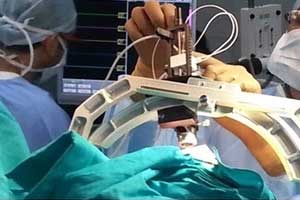NON METALLIC ROBOTIC NEUROSURGERY INSIDE MRI SCANNER
PROF DRRAM,HIV /AIDS,HEPATITIS ,SEX DISEASES & WEAKNESS expert,New Delhi,India, profdrram@gmail.com,+917838059592,+919832025033,ON WHATSAPP
Currently doctors are using robotic systems guided by magnetic resonance imaging (MRI) to perform the surgery. But the process cannot be done simultaneously while the MRI is in use due to interference from electromagnetic motors commonly used in robots.Doctors must often move a patient in and out of the MRI scanner to manually adjust the positioning of a needle. The needle needs to be inserted into the brain before proceeding.
 The new device was designed and developed by a University of Hong Kong mechanical engineering team and tested by neurosurgeons from the Chinese University. After five years of research and more than a dozen prototypes, the problem was resolved by developing a hydraulic powered robotic system.Non metallic Robots are being also developed to take care of Magnet of MRI Machine.
The new device was designed and developed by a University of Hong Kong mechanical engineering team and tested by neurosurgeons from the Chinese University. After five years of research and more than a dozen prototypes, the problem was resolved by developing a hydraulic powered robotic system.Non metallic Robots are being also developed to take care of Magnet of MRI Machine.
“This robot can accurately control and position the needle without affecting the MRI image quality during the operation ... and allows doctors to see in real time where the needle is placed,” explained Dr Kwok Ka-wai, who led the HKU team.This robot can accurately control and position the needle without affecting the MRI image quality
The design is more compact than current robotic systems and can simultaneously work on both the left and right sides of the brain, unlike those on the market. The engineering breakthrough could also help reduce the operating time spent by doctors in Hong Kong who rely on a more conventional method that takes between eight and 12 hours to complete.During surgery, the procedure is performed while the patient is conscious under local anaesthesia. Surgeons rely on verbal and physical interactions with the patient to ensure the electrode is accurately positioned.
The conventional procedure can take up to a whole day because doctors can only work on one side of the brain at a time and then repeat the procedures on the opposite side.“This process is quite time-consuming and creates pressure and discomfort for the patient,” Chinese University consultant neurosurgeon Dr Danny Chan Tat-ming said.Hong Kong tech start-up chief’s goal is to help sick and elderly with robotic devices
With the new device, patients can be put under general anaesthesia while doctors can operate from a control room.
The team plans to conduct further studies and hopes to carry out clinical tests on patients within the next two to three years.If successful, the technology could also be applied to other MRI-guided uses, such as biopsies for prostate or breast cancer.
- Kidney stones universally present hazard in north india,dillution by water prevent it
- Steroid and placebo effect equally for mild persisting asthma with low sputum eosinophils
- Government wants to fix public healthcare staff shortages with ayush docs: will it work?
- Plea in hc for payment of salaries of edmc, north mcd teachers and doctors
- 7 indian pharma companies named in us lawsuit over inflating generic drug prices
- Woman in up dies after explosion in her mouth during treatment,what is diagnosis?
- Woman in up dies after explosion in her mouth during treatment,what is diagnosis?
- Woman in up dies after explosion in her mouth during treatment,what is diagnosis?
- Air pollution ! mothers organising rally in london,anaesthetist choosing gas,will india follow?
- Cardiac arrest is always not sudden as understood -a study

 Comments (
Comments ( Category (
Category ( Views (
Views (